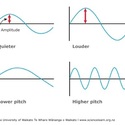Sound is a form of energy that is caused by the vibration of matter1. Sound is transmitted through waves, which travel through solids, liquids and gases2. We are most used to the sound travelling through air, but sound is able to travel faster and further in solids and liquids.
‘Seeing’ sound
If we could see the molecules3 that make up the air around us, we would see sound as a series of more and less dense areas of air that are moving away from the source of the sound at about 340 metres4 per second. We say sound is a wave because the air molecules move back and forth while the sound travels along. The air behaves much like a longitudinal or compression wave5 on a spring.
It is difficult to draw compression waves, so waves are generally represented as transverse waves6 for simplicity. The dense areas of the compression wave are the peaks of the transverse wave7 and the sparse areas are the troughs.
Microphone – transforming sound energy into electrical energy
In order to visualise a sound wave, we can use a microphone to transform8 sound energy into electrical energy. A simple microphone is made up of a very thin membrane with a coil of very fine wire attached. A magnet9 is positioned so that it is just inside the coil of wire but not touching it. When a sound wave strikes the membrane, it jiggles (vibrates) back and forth because of the high and low pressure areas of the wave. This causes the coil to jiggle, and when a coil moves in a magnetic field10, an electrical current11 is produced. If we look at the electrical current using an oscilloscope12, we can see the sound as a series of peaks and troughs.
The sound from single pitch13 or note will make a simple sine wave on the screen. The wave will change as you change the volume14 or pitch of the note.
Related content
This article is part of an article series:
- Sound – understanding standing waves
- Sound – resonance
- Sound – wave interference
- Sound – beats, the Doppler effect and sonic booms
with the accompanying investigations:
Additional articles and activity ideas
Find out more about studying sound under water and read about what is needed for sound to be heard, and how sound travels through water to understand some of the key science concepts.
Investigating waves and energy uses slinkies to explore longitudinal and transverse waves15.
Make and use a hydrophone explains how to construct an underwater microphone.
Sound on an oscilloscope uses a computer’s microphone to create a visual display.
The PLD article Physical World – Sound curates Hub resources for the early years through to year 10.
Visit the sound topic for additional resources.
- matter: The basic structural component of all things that have mass and volume.
- gases: The state of matter distinguished from the solid and liquid states. Gases have the ability to diffuse readily and to become distributed uniformly throughout any container.
- molecule: Two or more atoms bonded together. The molecule of an element has all its atoms the same. The molecule of a compound has two or more different atoms.
- metre: The base unit of length in the International System of Units (SI).
- longitudinal wave: Also known as a compression wave, where the material moves in the same direction as the wave moves, for example, sound waves.
- transverse wave: Where the material moves at right angles to the direction the wave moves, for example, water waves.
- transverse wave: Where the material moves at right angles to the direction the wave moves, for example, water waves.
- transform: To be given a completely different form or appearance.
- magnet: An object that generates a magnetic field that can influence magnetic objects such as iron and other metals.
- magnetic field: The zone around a magnet in which a magnetic force can be detected.
- current: The flow of electric charge through a conductor.
- oscilloscope: An electronic instrument used to observe and measure changing electrical signals.
- pitch: 1. (Flight) The movement of the nose (front) of an airplane or spacecraft up or down about a transverse axis. 2. (Sound) A human perception of how high or low the frequency of the sound being heard appears to be.
- volume: 1. The quantity of space occupied by a liquid, solid or gas. Common units used to display volume include cubic metres, litres, millilitres, tablespoons and teaspoons. (Volume can refer to a large quanity of something). 2. The degree of sound intensity or audibility; loudness.
- transverse wave: Where the material moves at right angles to the direction the wave moves, for example, water waves.





